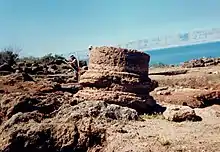Callirrhoe (Jordan)
Callirrhoe or Callirrhoë (Arabic: عين الزارة, 'Ein ez-Zara; Greek: Θερμὰ Καλλιρόης, Thermà Kallirhoēs) is an archaeological site in Jordan in which remains of a nymphaeum can be traced, though it is considered difficult to be interpreted. Callirrhoe is known in ancient literature for its thermal springs, because it was visited by King Herod according to Josephus[1] shortly before his death, as a final attempt to be cured or relief his pains. It remains unknown if the greatest builder in Jewish history[2] is related to any of the observable remains in the area. Callirrhoe is referred by Pliny the Elder (Natural History, 70-72), Ptolemaeus (Geography 15,6) and Solinus (De mirabilibus mundi 35,4)[3] as well as in a Midrash.[4]
عين الزارة | |
 | |
 Shown within Jordan | |
| Region | Eastern shore of Dead Sea, Jordan |
|---|---|
| Coordinates | 31°35′49.2″N 35°33′33.5″E |
| Type | nymphaeum thermae |
| History | |
| Founded | 1st century BCE |
Names
The Greek name Kallirhoē means "beautiful brook" or "spring". The Arabic name Ayn az-Zara is sometimes derived from the root zar'a ("to sow"), in view of the agricultural function of the oasis. More probable is its derivation from an unattested original form al-Ayn az-Zahra ("the shining spring"), acting as a direct calque of the Greek.[5]
Madaba Map

Callirrhoe is represented on Madaba Map. On the mosaic three constructions can be observed, a spring house, a nymphaeum, and a house.[6] Springs' waters are gathered in basins, and two little palm trees are discerned representing the oasis or the fecundity of this area because of the abundant fresh water supply.[7] Waters of the southern spring sprout from the mountain ending up in the sea.[8]
According to Al-Tamimi, the physician, Callirrhoe (formerly called aḏ-Ḏara), was the source of the highly sought-after "salt of Sodom" (Arabic: milḥ anḏrānī), a crystalline salt that is white, shiny and sticky.[9]
Archaeological surveys
Callirrhoe is identified as the present day oasis 'Ein ez-Zara, laying on the eastern shore of Dead Sea south of Wadi Zerka Ma'in in Jordan. It was founded circa 1st century BCE and excavations between 1985 and 1989 were directed by August Strobel on behalf of the German Evangelical Institute for the Ancient Holy Land.[10][11] A villa of the 1st century CE, uncovered in recent excavations, is considered to be inspired by the designs used by Herod for his palaces.[12] Callirrhoe functioned as harbor site for the mountain fortress of Machaerus. An ancient road of 8 km length connects the two sites.[13]

References
- Joseph. BJ 1.657; AJ 17.171 (Herod) went over Jordan, and made use of the hot waters of Callirrhoe, which run into the lake As-phaltitis, but are themselves sweet enough to be drunk.
- Spino, Ken (Rabbi) (2010). "History Crash Course #31: Herod the Great (online)". Crash Course in Jewish History. Targum Press. ISBN 978-1-5687-1532-2. Retrieved 7 May 2013.
- Avi-Yonah, Michael (1954). The Madaba Mosaic Map with Introduction and Commentary. Jerusalem: Israel Exploration Society. p. 40.
- Genesis R. 37
- Stefan Jakob Wimmer(2019). Kallirrhoë: Das Kurbad des Herodes. IN: Martin Peilstöcker, Sabine Wolfram (Hgg.): Leben am Toten Meer. Archäologie aus dem Heiligen Land. Chemnitz/Dresden: Staatliches Museum für Archäologie Chemnitz, p. 205
- Stillwell, Richard; et al., eds. (1976). "CALLIRRHOE (Uyun es-Sara) Jordan". The Princeton encyclopedia of classical sites. Princeton, N.J.: Princeton University Press.
- Donner, Herbert (1995). The Mosaic Map of Madaba: An Introductory Guide. Palestina Antiqua, 7. Leuven: Peeters Publishers. pp. 39–40. ISBN 978-90-390-0011-3.
- "Madaba Mosaic Map: Peraea and Dead Sea". Archived from the original on 16 April 2016. Retrieved 2 April 2016.
- Amar, Z. (1997). "The Incense Spices according to Rabbi Saadia Gaon (סממני הקטורת על פי ר' סעדיה גאון)". Sinai (in Hebrew). Mossad Harav Kook. 118 (1–6): 135.
- Netzer, Ehud (2008). Architecture of Herod, the Great Builder. Grand Rapids: Baker Academic. pp. 234–235. ISBN 978-0-8010-3612-5.
- Strobel, August (2003). Kallirrhoë ('Ēn ez-Zāra). Dritte Grabungskampagne des Deutschen Evangelischen Instituts für Altertumswissenschaft des Heiligen Landes und Exkursionen in Süd-Peräa. Wiesbaden: Harrassowitz.
- Magness, Jodi (2003). The Archaeology of Qumran and the Dead Sea Scrolls. Grand Rapids: Wm. B. Eerdmans Publishing. pp. 77–78. ISBN 9780802826879.
- Wimmer, Stefan Jakob (2019). "The Port of Machaerus: Callirrhoe – A Retrospection on the German Excavations (1985-1989) After 30 Years". In Vörös, Gyözö (ed.). Machaerus III. The Golden Jubilee of the Archaeological Excavations. Final Report on the Herodian Citadel 1968-2018. Jerusalem: Studium Biblicum Franciscanum. pp. 460–491.
External links
- "Madaba Mosaic Map". Archived from the original on 14 April 2016. Retrieved 2 April 2016.
- Photos of Ayn ez Zara at the American Center of Research